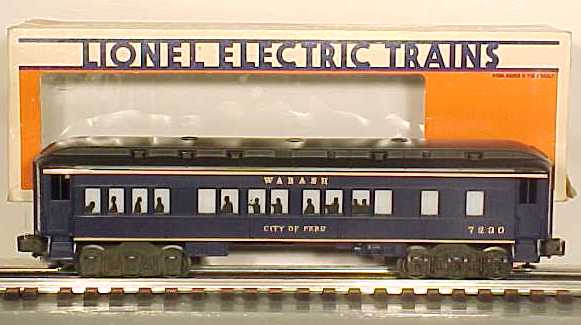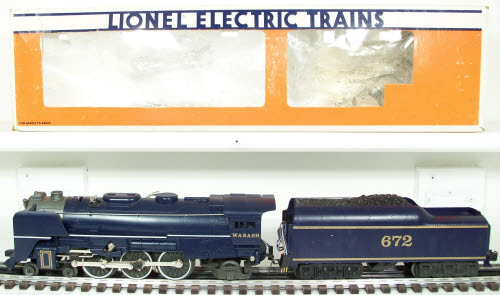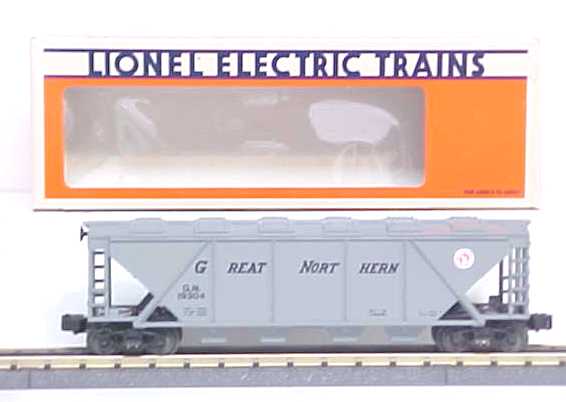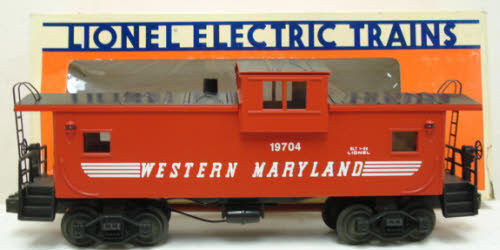The

Guide to
Lionel's Fallen Flags Sets (1986-93)







(Railroad logo images courtesy of Wikipedia.org)
(Photo of pages 2 and 3 of the 1986 Lionel Collectors' Series Catalog)
In 1979, Lionel introduced a series of top-of-the-line train sets commemorating five of the greatest railroads in American history. Known as the Famous American Railroad Series (FARR for short), they were a great success, and Lionel wanted to continue the theme-set idea. However, when the company first announced the FARR series it specifically stated there would only be five sets, so in 1986, a new series, the Fallen Flags, replaced the FARR series.
The Fallen Flags are named so because they commemorate railroads that were merged into other systems (for more information on the actual railroads in the Fallen Flags series, see below). In all seven Fallen Flags sets were produced between 1986 and 1993, and one was catalogued every year except 1990.
The Fallen Flags sets were produced during a time of great transition at Lionel. The company was breaking away from the technological stagnation of the MPC Era (1970-86) and was beginning a period of exciting innovation. As new features such as Railsounds became available, they were incorporated into the Fallen Flags sets. The cars were all typical for Lionel at the time, with operating couplers and die-cast trucks. The cabooses for all of the sets were lighted.
The series may have undergone some running changes in terms of the road names planned for the sets--in the 1986 catalog, which premiered the FF series, there is a picture of several road names, of which only about half of which made it into production. Others in the photo, such as the New York Central and Rock Island, never were produced as Fallen Flags.
The sets were similar to their FARR predecessors, but there were some notable differences. Whereas the FARR sets were always headed by a steam locomotive, the Fallen Flags featured a more diverse locomotive roster, including a steam engine, an electric, and a host of diesels. The FARR sets had a very structured format in terms of the rolling stock (boxcar, tank car, refrigerator car, hopper, caboose, and one extra add-on car), but the Fallen Flags sets were assembled in a more random fashion, and this series even featured a passenger set. Each piece in the FARR series has a special diamond logo on the each side, but the Fallen Flags have no such signature emblem, making it sometimes difficult to delineate FF engines and cars from regular Lionel production.
Lastly, unlike the FARR series, which had a definite starting and ending point, the Fallen Flags were abruptly discontinued after 1993.
Below are pictures and a description of each Fallen Flags set, and in the section following are some notes about the relative value and scarcity of each set.
Fallen Flags Set #1--Wabash Railroad (1986-87)
The Wabash was the first of the Fallen Flags, introduced in the 1986 catalog, the last catalog of the MPC era. As a result, it is the only Fallen Flags set to carry the old four-digit numbering system, which was replaced the following year by the five-digit system of Lionel's Modern Era.
This was the only passenger set included in the FF series. It is also the only set where the production models differed greatly from the prototype shown in the catalog. The 1986 catalog showed a lighter blue set on a blue background, and the entire train looked a bit 'blah' in the photos. But when the set was released, the color was much darker and more striking, and the Wabash set was a hit when it was first released.
The engine features the electronic sound of steam, a whistle, and magnetraction. Lionel used its classic Small Hudson boiler, but in place of the normal four-wheel rear truck, a two-wheel version was substituted, resulting in the first 4-6-2 in Lionel history. It would turn out to be the only steam engine to head up a FF set. The cars are all lighted and have die cast trucks.
1986 was a rough year for Lionel, as its management bounced between Fundimensions, Kenner-Parker Toys, and finally to Lionel Trains, Inc. The Wabash set was caught up in the production delays that plagued Lionel throughout the mid-80s, and the set was not released until early 1987.
In 1987 the set was catalogued again, this time shown in the correct colors.
Fallen Flags Set #2--Milwaukee Road (1987)
|
Pages 28 and 29 of the 1987 Catalog |
|
||||

18500 Milwaukee Road GP-9 Diesel |
|
The second of the Fallen Flags honored the Chicago, Milwaukee, St. Paul and Pacific, better known as the Milwaukee Road. The set was headed up by a GP-9 diesel with magnetraction, but no sounds. Unlike the Famous American Railroad sets, which always included five freight cars in the initial release, the Milwaukee set a precedent for future FF freight sets and had six--a boxcar (19204), refrigerator car (19500), hopper (19302), gondola (19400), tank car (19600), and a caboose (19701).
|
The Milwaukee Road featured an add-on car, the 19515 Milwaukee Road stock car. It was introduced in 1990 and was uncatalogued.
|
 |
Fallen Flags Set #3--Great Northern (1988)
|
Pages 26 and 27 of the 1988 Catalog |
|
||||

18302 Great Northern EP-5 Electric |
|
Set number three was decorated for the Great Northern and was in the 1988 catalog. For a locomotive, Lionel went with the EP-5 Electric. This engine is actually a model of an electric built for the New Haven, but it bears a faint resemblance to the W-1 electrics used by the GN over its electrified division in the 1940s and 50s. The engine has a headlight and an electronic horn.
The six cars included the 19205 double-door boxcar, 19505 refrigerator car, 19400 gondola with a removable coal load (the first such load included with a Lionel gondola), 19402 crane car, 19304 covered hopper, and a 19703 extended vision caboose. No add-on cars were made for this set.
The Great Northern was the only railroad included in both the Famous American and the Fallen Flags series. Both GN sets were the third in their respective series.
This set was a bit of a slow seller when introduced. It seems that too much of the set was a repeat--the GN EP-5 had been made only ten years before (#8762)and the Great Northern FARR set had been made only seven years previous.
Fallen Flags Set #4--Western Maryland (1989)
|
Pages 6 and 7 from the 1989 Pre-Toy Fair Catalog |
|
||||

18501 Western Maryland NW-2 Switcher w/Bell |
|
By 1989 the Fallen Flags were making a regular appearance in the Lionel catalog. The fourth set in the series--the Western Maryland--was produced that year. This set was unique for several reasons. First was the locomotive, a NW-2 switcher. A small switcher might seem an odd choice to head up a set like this, but for the 18501 Lionel brought back the quality switcher design of the early 1950s, with a die-cast frame, large pullmor motor, and a working mechanical bell. Cosmetically the engine also included a radio wheel and extra handrail details, which also had not been seen on a Lionel switcher since 1954.
The 19601 North American tank car was the first Fallen Flags car not lettered for the railroad featured in the set. Also, the 19704 caboose included a smoke unit.
No extra cars were made for the WM set.
Fallen Flags Set #5--St. Louis-San Francisco [Frisco] (1991)
|
Pages 16 and 17 of the 1991 Book One Catalog |
|
||||

18504 (504) Frisco GP-7 Diesel |
|
After four straight years near the top of the Lionel line, the Fallen Flags series took a year off in 1990. The year 1990 was a year of innovation at Lionel, as the new Railsounds technology was introduced to the full line (it was 'tried out' in a couple engines in 1989). When the Fallen Flags returned in 1991 with the fifth edition, decorated for the St. Louis-San Francisco Railway, it was natural that this new feature would be included.
Early Railsounds circuit boards and wiring were cumbersome and too large to fit in a mid-size locomotive, so the sound unit was installed in a boxcar instead. The 19229 boxcar contains the sound boards, wiring and speaker, and by opening the door all of the Railsounds guts can be easily seen.
The engine used for set number five was a standard Lionel GP-7, like the one used for the Milwaukee Road set in 1987. However, like the Western Maryland NW-2 from two years earlier, the Frisco GP-7 included some upgraded features, such as Magnetraction and handrails on the noses.
The other components of the Frisco set were pretty standard Fallen Flags fare, but the the 19408 included the new coil cover load that started to appear with Lionel gondolas in the early 1990s.
Two add-on cars were made for the Frisco set the following year, a 19412 crane car and a 19413 flatcar. They were the last add-on cars produced for any Fallen Flags set.
Fallen Flags Set #6--Nickel Plate Road (1992)
|
Pages 16 and 17 from the 1992 Book One Catalog |
|
||||

18505 Nickel Plate Road GP-7s W/Railsounds |
|
The sixth set in the Fallen Flags series commemorated the great Nickel Plate Road. Introduced in 1992, the NKP set essentially followed the format of the fifth set, but with a couple of changes. The most noticeable was the inclusion of a non-powered diesel with the Railsounds unit installed in it, versus the boxcar installation in the Frisco set. Railsounds units in boxcars tend to echo, and by putting the sound unit in a car that car was essentially 'married' immediately behind the engine, lest set have some odd sound effects. The other change was that a traditional steel-sided caboose replaced the extended vision model found in the previous four FF freight sets.
Eagerly anticipated when announced, the Nickel Plate set was a bit of a disappointment. It had a somewhat drab appearance compared to the previous sets. More importantly, for one of the few times in its history Lionel completely whiffed on the time period of a set. The NKP was merged out of existence in 1964, but the Sears trailer is decorated in lettering not used by Sears until the 1980s, and the brown 1930s-type steel-sided caboose seemed an odd choice for a set headed by GP-7s, and the sharp red bay-window models used by the NKP during the early diesel era would have been a great choice for this set. The entire train seems a bit mismatched, which is a shame considering that the Nickel Plate is a very popular road name with many collectors and the railroad was a perfect addition to the series.
No extra cars were made for the set.
Fallen Flags Set #7--Erie (1993)
|
Pages 16 and 17 of the 1993 Book One Catalog |
|
||||

18504 (504) Frisco GP-7 Diesel |
|
The final Fallen Flags set was made in 1993, and was decorated for the Erie Railroad. Lionel tried another innovation with the motive power for this set, heading it up with a set of ABA Alco diesels. Like the Western Maryland NW-2 in 1989, Lionel upgraded the Alcos with die-cast frames and trucks last seen in 1954, and the engines bore a resemblance to the 2032 Erie Alcos from the early 1950s. But in the process of upgrading the Alco design, Lionel ran into a problem installing the newer magnetic couplers. To provide clearance for the coupler armatures to pull down and open, the front coupler aprons were pushed back under the engines. This gave the engines a 'bucktoothed' appearance that was very unpopular with collectors. The engines also lacked Railsounds, perhaps a sign that after seven years the Fallen Flags were dropping down Lionel's priority list.

The cars were typical for the FF sets, and the hopper, flatcar and caboose were particularly popular. No add-on cars were made for the set.
Rarity and Value
The Wabash is the only Fallen Flags set that could be considered difficult to find, but it is still much easier to locate than many other Lionel limited-production items. All of the Fallen Flags freight sets are relatively common, as they were produced when Lionel's popularity began to return in the late 1980s. The Lionel catalog was still somewhat skimpy by today's standards, but increasing demand for Lionel trains meant that what was in the catalog was produced in large quantities. This is a common phenomenon of Lionel production during the LTI era (1987-95).
The Railroads
While just about any railroad around in 1950 not named 'Union Pacific' is today considered a Fallen Flag, the seven railroads selected by Lionel for this series all have interesting stories:
 |
The Wabash Railroad--The Wabash had its beginnings just after the Civil War, and over time grew to a system serving much of the Midwest. The Wabash had a key advantage over its competitors--unlike most East and Midwest railroads that stopped in either Chicago or St. Louis, the Wabash's main line from Detroit went through to Kansas City, giving it a route that bypassed the congestion around Chicago. Controlled by the Pennsylvania Railroad for much of the early 20th century, in the early 1960s the PRR was forced to divest of the Wabash prior to its own merger with the New York Central. The Wabash was leased by the Norfolk and Western in 1964, and eventually merged into the Norfolk Southern. |
 |
Chicago, Milwaukee, St. Paul and Pacific (Milwaukee Road)--By the beginning of the 20th Century the Milwaukee Road was considered one of the strongest railroads in the Upper Midwest, connecting Chicago, Kansas City, Minneapolis, Milwaukee, and just about every other spot in between. In the early 1900s the decision was made to extend the railroad to Seattle; this along with the decision to electrify much of the new route bankrupted the railroad in the 1920s. The Milwaukee Road recovered during WWII but got caught in the general decline of railroads in the 1960s. It staggered through the '70s, abandoning the line to Seattle in 1977, and was finally merged into the Soo Line (Canadian Pacific) in 1985. Most of the road's routes have been abandoned. |
 |
Great Northern--The GN is notable as being one of the few transcontinental railroads built without the assistance of Federal land grants. The GN was the brainchild of Minneapolis businessman James J. Hill, and over time the GN worked west to Seattle, Washington and Portland, Oregon. The GN was considered the strongest and best-built of the northern transcontinental railroads, and when it merged with Northern Pacific as part of the Burlington Northern merger in 1970, most GN routes were kept over the NP's lines. |
 |
Western Maryland--The product of Baltimore business interests, the Western Maryland extended from Baltimore into eastern West Virginia and southwest Pennsylvania. It formed part of the 'Alphabet Route', a group of eight railroads connecting Chicago to New York. WM called itself the "Fast Freight Line", which it was, but it also drug lots of coal from the mines in West Virginia down to Baltimore Harbor. The larger rivals Chesapeake and Ohio and Baltimore and Ohio bought a stake in the WM in the mid-1960s, and the WM became part of the Chessie System in 1973. |
 |
St. Louis-San Francisco (Frisco)--No railroad in America had a map quite like the Frisco's, an X-shaped railroad with one line from St. Louis through Oklahoma City to the Texas Panhandle, and another line from Kansas City through Memphis to Birmingham, Alabama. The two lines crossed in Springfield, Missouri. Besides its abundant traffic on-line, the Frisco was a bridge between the railroads of the Upper Midwest and the South. Given its strategic location, it was inevitable that someone would take it over, and the Burlington Northern merged the Frisco in 1980. |
 |
New York, Chicago and St. Louis (Nickel Plate Road)--The NKP was built as a competitor to the larger New York Central along the south shore of the Great Lakes, and eventually the railroad extended to St. Louis and Peoria, Illinois. Like the Western Maryland, the Nickel Plate was part of the New York-Chicago Alphabet Route. The Nickel Plate prided itself as a fast freight carrier and was one of the last railroads in America to run steam locomotives. It merged with the Norfolk and Western in 1964. |
 |
Erie Railroad--Chartered by the State of New York in the 1830s, the Erie suffered more trials and tribulations than perhaps any other major railroad in the country. It went through numerous bankruptcies and scandals, including a period of ownership by robber baron Jim Fisk, who used the Erie as a means to battle Cornelius Vanderbilt and his New York Central empire. By the early 1900s the Erie settled down as the smallest of the four Chicago-New York trunk railroads. In 1960 Erie merged with the Delaware, Lackawanna and Western to form the Erie Lackawanna, and that railroad became part of Conrail in 1976. Most of the Erie's lines have been abandoned in favor of routes laid out and constructed better than Erie's, but some in New Jersey and New York remain. |
Conclusion
Lionel did not announce that the Erie set would be the last of the Fallen Flags sets. Without fanfare, the series went away in 1994 and never returned. Exactly why this happened is a mystery, but some personal observations may help explain.
While in high school and college I worked part-time at a retail hobby shop in the late '80s and early '90s. I remember when the Western Maryland set first premiered there was a lot of interest in it. For the subsequent sets the reception seemed less enthusiastic, to the point that the Erie set seemed to pass by without notice.
By the mid-90s, customer attitudes and demand for certain products were changing. Counting the Famous American Railroad Series, a separate-sale freight set had been almost continuously in the Lionel catalog for 15 years. Collecting fatigue was a factor in the decline of the Fallen Flags, as was a change in Lionel's production and marketing strategy. Starting in the mid-90s, separate-sale item sets disappeared and large sets sold in one package returned as Lionel's primary way to sell top of the line sets. This one-stop shopping made it easier and less frustrating for Lionel fans to build their collections.
Today the Fallen Flags are a symbol of the LTI era. Easy to find and to collect, they are a nice reminder of the time when Lionel regained its past glory.
Tommy Feldman
General Manager, Trainz.com
July 2009
Credits and Acknowledgements
The photos in the article were all taken at Trainz.com between 2001 and today.
Much of the information in the article was attained through observations and notes taken here at Trainz. David Doyle's Standard Catalog of Lionel Trains, 1970-2000, Roland LaVoie's Greenberg's Guide to Lionel Trains, 1970-91 (Volumes 1 and 2) were very helpful in filling in some gaps of information in the article.
Some information on the histories of the railroads is from George Drury's Historic Guide to North American Railroads, www.wikipedia.org, and William Middleton's When the Steam Railroads Electrified.
If anyone reading this article has any corrections, further information, or photographs of these cars that could enhance this article, feel free to contact me at tommy@trainz.com.
--Tommy













































